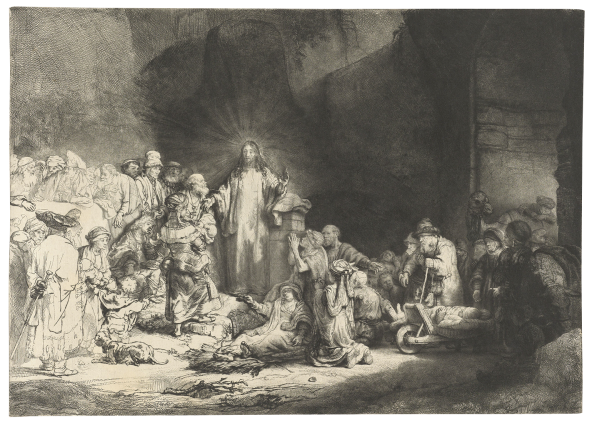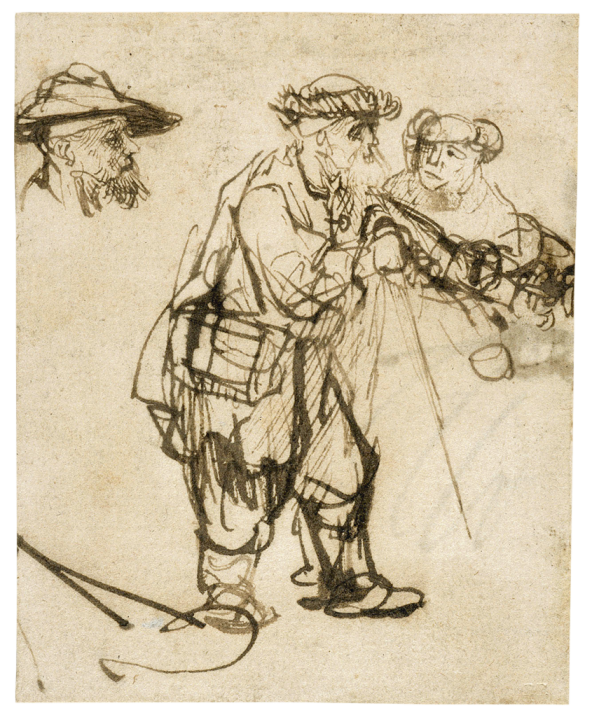Choose a background colour
Rembrandt van Rijn, Dutch, 1606-1669: Man with a Walking Stick Wearing a Fur Cap, c. 1648
Black chalk on paper
5 1⁄16 × 3 11⁄16 in. (12.9 × 9.4 cm)
Verso, upper center, in red chalk, f 4-:- (possibly seventeenth- or early eighteenth-century hand); in pencil at lower center, H.d.G 309 and 100229; and upper right, 5.
- Chain Lines:
- Vertical, 24 – 25 mm (25|24|25)
- Watermark:
- None.
- Provenance:
Unidentified collector, eighteenth or nineteenth century (Lugt 4847, paraph on verso with Roman numeral classification, X); Friedrich August II, King of Saxony, 1797 – 1854, Dresden (Lugt 971, stamp on recto); dealer, P. & D. Colnaghi, London, 1949; Percy Moore Turner, 1877 – 1950, London; sale, Sotheby Mak van Waay, Amsterdam, 18 November 1980, lot 50a; Sheldon and Leena Peck, Boston (Lugt 3847); gift to the Ackland Art Museum, inv. no. 2017.1.65.
- Literature/Exhibitions:
Lippmann 1888 – 91, vol. 1, no. 140a; Michel 1893, 92; Hofstede de Groot 1906, no. 309; Friese & Wichmann 1925, vol. 3, no. 117; Benesch 1935, 38; Benesch 1954 – 57, vol. 4, 194, no. 724, fi g. 869; Slive 1965, vol. 1, no. 144; Benesch 1973, vol. 4, 190, no. 724, fi g. 917; W. W. Robinson in Gnann & Widauer 2000, 303 – 06, fi g. 4; Bevers 2006, 112, 142 – 43; H. Bevers in New York 2016, 50, 64 – 65 (notes 39 – 40); Schatborn & Hinterding 2019, 264, no. D427.
- Ackland Catalogue:
- 2017.1.65
This sensitive portrayal of an old man dressed for the cold and holding a walking staff is the only chalk drawing by Rembrandt in the Peck Collection. Likely drawn from direct observation, it belongs to a larger group of studies depicting the poor and elderly and reveals Rembrandt’s ability to capture a person’s character, in this instance tired yet resolute, with very few lines. The study may have been used as a preparatory design for the artist’s famous etching Christ Healing the Sick (The Hundred Guilder Print) of around 1647 to 1648, which features a similar figure.
In the late 1640s and early 1650s, Rembrandt made a number of black chalk figure studies depicting beggars, the itinerant poor, elderly, and crippled, most of which appear to have been sketched from life amid the various aggregations of people on the streets of Amsterdam.1
The Peck study is one of the most fully realized to survive from this group of around forty works, not only in terms of its degree of finish but also in what might be called Rembrandt’s sympathetic spirit when closely observing the humanity around him. Rembrandt effortlessly captured the character and bearing of this man with a remarkable economy of line using broad swift strokes, only sparingly applying the sharp point of the chalk for reinforcement along certain edges. The resulting image superbly balances the central massing of the man’s body against the weight he exerts on the walking stick, tired but holding strong.
As Holm Bevers noted, Rembrandt appears to have reserved these black chalk figure studies for his own use, rather than circulating them among his studio assistants and students.2
Many of these figures recur in various forms in some of Rembrandt’s biblical and genre subjects from circa 1647 to 1652, which is one of the main rationales for dating drawings in this group to these years.3
Given the similarity in size of a number of sheets, he may have been working from one or more portable sketchbooks. Peter Schatborn recently dated this particular sheet toward the later side of this group, circa 1652, though it remains difficult to order these black chalk studies.4
There are good reasons to consider a slightly earlier date. A corresponding figure to the one seen here, though not adopted literally, is found in Rembrandt’s famous etching from circa 1647 to 1648, Christ Healing the Sick (The Hundred Guilder Print), in which the blind man standing behind the wheelbarrow holds a walking stick and wears a similar fur cap Fig. 24.1.5

Rembrandt, Christ Healing the Sick (The Hundred Guilder Print), c. 1647 – 48. Etching and drypoint on paper, 280 × 394 mm. Amsterdam, Rijksmuseum, inv. no. rp-p-ob-601.
Rijksmuseum, Amsterdam
Rembrandt drew a number of studies in pen and ink that are clearly designs for this etching.
One in the Louvre recasts the figure as a blind man with a greater stoop, shown assisted by the woman holding his arm, and depicted in reverse (as one would expect) in preparation for the print Fig. 24.2.6

Rembrandt, Blind Man Led by a Woman, c. 1647 – 48. Pen and ink on paper, 122 × 98 mm. Paris, Musée du Louvre, inv. no. 22891.
RMN-Grand Palais/Art Resource, NY
Scholarship remains divided on whether the Peck drawing should also be considered a preparatory study for Christ Healing the Sick. Schatborn and Martin Royalton-Kisch did not add this sheet to their “core list” of Rembrandt’s drawings, that is, those that should be considered indisputably by Rembrandt’s hand based on incontrovertible criteria. By definition this includes all drawings preparatory for other works.7
Bevers, on the other hand, viewed this exclusion as a mistake, since he regards this figure as a study that Rembrandt clearly referred to when completing the etching.8
The debate turns somewhat on the semantics of the term preparatory. The Peck drawing obviously functions as an independent study, one that gives every appearance of having been made from life, and that serves in the simplest terms as a depiction of a man dressed for travel in cold weather. In that sense, it is completely unrelated to the compositional and narrative aims of Christ Healing the Sick. At the same time, it appears that Rembrandt returned to this figure at some point while working on the print or while drawing the figure in the Louvre study. While none of Rembrandt’s black chalk figure studies recur in their exact form in his finished works, he indeed seems to have made regular use of them, especially when it comes to issues of character and costuming.
The clothing of non-natives such as the Ashkenazi Jews from Poland who flooded into Amsterdam at the time, many of whom settled in Rembrandt’s neighborhood, were of great interest to the artist. He adopted some of these figures and their attire in his historical and biblical works.9
While it is difficult to posit a national or cultural origin for this particular type of fur cap, it rarely recurs in Rembrandt’s drawings, being found only in this sheet and in the aforementioned Louvre study. It is likely that the Peck drawing proved useful for the figure of the blind man in Christ Healing the Sick, and that it was probably made around the years 1647 – 48, a date range that Bevers considers probable for this group of black chalk figure studies as a whole.10
End Notes
For this group of Rembrandt’s black chalk figure studies from mid-career, see Robinson 1998; idem in Gnann & Widauer 2000, 303 – 06; Bevers 2006, 112 – 23; and Royalton-Kisch 2015. Some scholars find debatable the issue of whether these studies were drawn from life or not (e.g., Robinson in Gnann & Widauer 2000, 303), but their smaller format and subject matter suggest they once comprised one or more sketchbooks the artist used to record urban figures directly; see also Bevers 2006, 112.
Bevers 2006, 113. Worth noting, however, is that one of these black chalk figure studies long thought to be by Rembrandt in the Kupferstichkabinett, Berlin (Bevers 2006, no. 31) was revealed in 2012 to be a copy by a follower when the original turned up in an attic in Scotland, now in a private collection in Los Angeles (Schatborn & Hinterding 2019, no. D396).
See Robinson 1998, 36. The only somewhat firm “anchor” in dating this group is the Blind Beggar and His Family in the Amsterdam Museum (Schatborn & Hinterding 2019, no. D389; and Broos 1981, no. 13) that bears a preparatory sketch on the verso for Rembrandt’s 1647 etching Portrait of Jan Six (Bartsch, no. 285; and NHD Rembrandt, no. 238).
Schatborn & Hinterding 2019, no. D427.
Bartsch, no. 74; and NHD Rembrandt, no. 239.
Schatborn & Hinterding 2019, no. D92; and C. van Tuyll van Serooskerken in Paris 2006, no. 36.
Royalton-Kisch & Schatborn 2011b. The only black chalk figure study from this group that they included on this list is the aforementioned Blind Beggar and His Family (see note 3 above); idem, no. 58.
Bevers 2006, 112; and Bevers in New York 2016, 50, 64 – 65 (notes 39 – 40).
See the discussion by W. W. Robinson in London, Paris & Cambridge 2002 – 03, 120 – 21, under no. 47.
Bevers 2006, 112.
